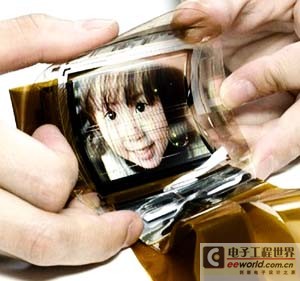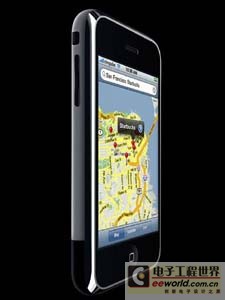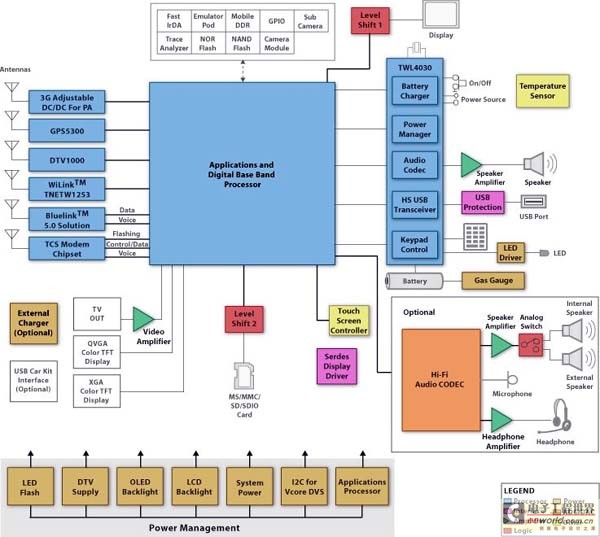Display design solutions for smart PDA phones
Modern mobile phone handsets are not just voice applications. New electronic technologies are gradually being applied to mobile phone design. For example, high-end models are integrating multiple applications such as Internet telephony, navigation, multimedia audio and video, mobile TV, etc., plus Wi-Fi, 3G, WiMAX, LTE... and other wireless technologies continue to innovate and mature, making mobile applications more diverse and diverse. However, in the face of continuous addition of functions, it also represents a continuous increase in power consumption. How to meet the display requirements and the low power consumption requirements has become a severe challenge that cannot be avoided by new mobile phone display panels...
This article refers to the address: http://

In 2007, Apple Computer launched the iPhone in the United States, creating a wave of smart phone sales, and then the sales volume of smart phones is also rising. According to IMS Research market research, the market share of smart phones will exceed 25% in 2012. After 5 years, one out of every four mobile phones in the world is a smart phone or a PDA phone! At present, in addition to Nokia, Motorola, and other communications companies actively import smart phones, HTC and Microsoft have entered the battle.


Analysis of the iPhone has caused a hot buying trend. Its main feature is that the iPhone has a dazzling screen image, which not only has a wide and clear perspective, but also features a multi-touch touch screen function. At the same time, with the release of Apple iPhone products. It also drives touch-sensitive display panel business opportunities. Touch panels attract more consumer electronics products to emulate and adopt, including: mobile phones, NB, MP3, ultra-mini computers (UMPC), etc., portable electronic devices, and gradually related applications .
In addition to touch technology, the key panel technology of mobile devices is also gradually becoming more and more mature, so that the display requirements of mobile devices can be more choices. For example, flexible electronic papers have been developed by manufacturers to display color display technology. The commercialization technology of AMOLED, as well as mobile phones, digital cameras and other products have been adopted one after another, making the technical battle of the display of mobile devices more and more exciting.
How to solve the power saving needs of mobile devices
New smart PDAs or mobile phones tend to offer a variety of additional functions such as traditional mobile communications and multimedia... including digital cameras (DSC), music players (MP3), video conferencing and global positioning systems, and even portable digital broadcast television... And so on are all integrated. With many additional requirements, different power supply voltages and current demands are increasing, making power consumption an urgent problem to be solved.
How to reduce the package space and support more power output at the same time? Power-system-on-a-chip design, such as integrated parts, will help mobile phone power application efficiency; how to achieve optimal efficiency and extend battery life while reducing power noise interference ? Pay attention to the relevant power solutions.
For example, when selecting power management systems such as charge control, battery monitoring, and battery protection, carefully configure power conversion components, such as switching-based power converters based on inductors and built-in FET switches, to ensure overall efficiency; The type of mobile phone is designed with different power requirements. For example, the voltage controlled oscillator (VCO) and phase-locked loop (PLL) are used for the RF, and the power supply with extremely low noise and high power rejection ratio is required.

It is also necessary to maintain the DC converter switching frequency, and its 2nd and 3rd order harmonics, in the IF band. Dynamic/Adaptability Voltage Regulation (DVS/AVS) is used to connect the processor and regulator in a closed loop system to ensure proper system operation and dynamically adjust the output voltage of the digital power supply to a minimum.
The power amplifier will therefore also be optimized for maximum transmit power for maximum efficiency. Using the latest process technology, it is easy to quickly modify and utilize existing discrete component designs to provide semiconductor wafers with different levels of integration. In addition, the new display technology OLED display, by its superior contrast value, fast response time and broad viewing angle advantages, expands market share, so it needs to be controlled by different materials such as polymers or small molecules, active or passive matrix, current and Voltage drive technology, as well as different bias supply circuits, etc., evaluate different solutions.
The passive matrix display requires a set of power boost converters, the active matrix display requires a positive/negative bias power supply, etc., and uses a miniature DC converter that can reduce the board area to assist the analog output power supply on the analog circuit. And reduce noise design, providing isolated power conversion to ensure compliance with safety requirements such as industrial applications and telecommunications, medical equipment, etc.
Adopting integrated and distributed intelligent power system design, such as using bqJUNIOR chip, it can collect all necessary information and perform related logic calculations, which will help system host processor related algorithms to develop and reduce product development time. With cost. For example, the TIOMAP1710 application processor is a good match. With the OMAP5910 embedded chip, you can get the required power information for effective energy saving and security control.

Finally, it is recommended to use the power system-on-a-chip (PSOC) integration function, which is relatively helpful for mobile communication, especially for high-end smart PDA or mobile phone development. The streamlined component goal of the versatile integrated system not only significantly reduces manufacturing costs, reduces board area, streamlines product assembly and process, but also reduces system reliability testing, helping to integrate higher-level wafers and process efficiency In order to speed up product mass production and time to market, to ensure product competitiveness.
For example, the TI TPS65010 is a high-integration, high-performance power system single-chip PSOC. Specialized in supporting mobile communication related power management requirements applications, including PDAs, digital cameras, multimedia smart phones, etc.; as long as the system uses a single lithium battery or lithium polymer battery, and contains multiple sets of power lines and advanced application processors, TPS65010 It can handle power system integration for optimal operational performance.
TPS65010 can effectively reduce the board area, up to 1/3 board area of ​​traditional circuit design, built-in 2 synchronous DC buck converters, integrated FET transistors, etc., for system power supply 1A conversion and processor core The power supply is converted to 400mA, achieving 97% conversion efficiency in the maximum operating mode.
Domestic panel factory technology development status
MVA (Multi-Domain Vertically Aligned) was developed by Fujitsu, Japan. Its technical feature is that under the original no-voltage state, the liquid crystal molecules are arranged perpendicular to the glass panel, indicating that the light is blocked into a black shape, and the voltage is applied. After that, the liquid crystal molecules are inclined horizontally, and then receive and penetrate the image light. The advantages of MVA technology include high contrast, wide viewing angle, no grayscale inversion, high resolution, fast response time, etc.
Currently, ViewSonic adopts the improved SuperClear MVA technology, which greatly improves the disadvantages of uneven brightness and narrow viewing angle of traditional LCD screens, and also improves the contrast of image products and optimizes color display.
AUO's design considerations in MVA are to improve the viewing angle of LCD TVs and the phenomenon of big-view roles. At present, we have developed a new generation of AMVA (AUO Advanced MVA) technology, which uses more than traditional MVA technology. Domains (Domains), to solve the problem of the role of the big vision, while achieving a super wide viewing angle of 178 degrees, greatly increased to over 5,000: 1 super high contrast, and more realistic and vivid colors and better image quality .
In addition, based on improving the dynamic image response speed, ASPD-Simulated Pulsed Driving is used to effectively solve the LCD image sticking problem, and the ASPD-Full HD 120 Hz Driving is used to increase the frame rate. This technology also improves the dynamic picture response time ( About 4ms grayscale; MPRT 8ms), effectively improve the performance of dynamic image quality. In addition, AUO develops a higher contrast of the portable display wide-angle viewing angle (AMVA-mobile) technology, a wider viewing angle and a faster reaction rate between grayscales, and maintains high penetration rate, etc., and is effectively applied to digital cameras and Small size LCD screen applications such as mobile phones, PDAs, etc. AUO has also developed HiColor technology, which has a color saturation of 1.33 times that of traditional liquid crystal displays. It is a RGB 3 primary color mixed LED backlight module, which can increase the color reproduction degree from NTSC 72% to NTSC 105%. Enhance the color of the bright and full and bright effect.
Touch panel technology competition status
Mobile device's additional touch screen function has recently become a design boom. Freescale is trying to introduce a touch screen controller for industrial human interface (HMI) applications. Its embedded processor MCF5227x LCD uses 32-bit arithmetic for high efficiency. Human factors control system design with energy, integration and design flexibility meets the needs of commercial and industrial applications. For example, adding a screen touch function to the graphic display interface does not require designing a large number of separate controllers and other components.
This highly integrated component, combined with a single-chip color LCD and touch screen controller, makes it easy to use a touch-sensitive interface for a variety of control applications. According to Freescale, the processor also includes building/home automation, HVAC and lighting control systems, fire/safety control systems, medical and patient monitoring products, test and measurement devices, point-of-purchase (POS) systems, and large appliances. Applications such as cooking, freezing and washing machines, etc., show the future touch screen operation applications and roles, and will be far-reaching.
From a technical perspective, the resistive touch screen will still be the mainstream in the market at this stage. Because of its low price and the ability to operate with fingers and stylus, even if the resistive touch screen is not durable and conductive, it is less sensitive. The low price advantage also makes this technology application temporarily dominate the market, which is currently popular in Kiosk, retail channel, financial, e-book and medical markets.
Considering the projected capacitive touch screen, the durability and conductivity are better than the resistive type. Many manufacturers are developing this technology. The Apple iPhone touch screen uses projected capacitive technology. How do future touch panels meet specific functional requirements and differentiation? It will be the key to improving product profitability. Similar to anti-glare, low-reflection, anti-palphael touch, etc., for small-sized consumer mobile devices, light, thin, short, and urinary are product trends, and touch panels must be thinner, lighter, and lower cost. Work hard.
At present, Apple's iPhone touch panel chip is based on Synaptics, which is based on capacitive sensing technology. Xinsi notebook touch panel has a global market share of 60%, and is expected to actively invest in the mobile touch panel market in the near future. Its supply customers include Comet and LG to launch PRADA phones...etc. Synopsys also targets Taiwanese foundries as its target customers, mainly focusing on Taiwan as the world's largest foundry base: including NB (80%), LCD monitors (66%), etc., as well as mobile phones, GPS, etc. Production base. Synopsys has established a design and development center in Taiwan to provide customers with customized touch technology, which is expected to shorten the time course from product design to launch.
Since the US and Japan's Synaptics, ALPS, TI, etc. have mastered some patents, the validity period of the resistive and capacitive touch panels has expired. And Taiwan's touch panel manufacturers such as Elan, Xunjie and Weiquan Electric... have been working on capacitive touch panel technology for a long time, and future business opportunities will be available.
Mobile device display panel future technical focus
High resolution: High-quality display with QVGA or higher specification than QVGA has become the mainstream specification for multimedia mobile phones. For example, in the first 1-2 quarters of 2007, QVGA has accounted for more than 33% of the total TFT LCD shipments of mobile phones. . Future PDA or mobile phone panel resolution will continue to advance to VGA or WVGA. Especially popular GPS maps, web browsers and video playback functions are expected to have VGA resolution, and the world's highest resolution mobile phone was originally NEC N904i ​​(3å‹, 854×480) models, but NTT DoCoMo in 2007 At the end of the year, 10 864×480 resolution phones were launched in one breath. Therefore, VGA-grade PDAs or mobile phones are expected to reach approximately 10% in 2010.
High color rendering: The multimedia display can reach 16.77 million colors, which will gradually be imported into multimedia mobile phones. The color saturation is more than 90% from NTSC 72%. The Japanese models use similar LCD TV-level panels. TFT LCD is no longer using less than 65,000 color driver ICs, and even some CSTN LCDs or PMOLEDs have used 65,000 colors or even 260,000 color driver ICs. At present, Taiwan's 16.77 million color driver IC shipments are still less than 10%. At present, Nokia has introduced a total of 16.77 million colors in high-end mobile phones, while other manufacturers have gradually followed up. In the past, the color saturation of TFT LCDs for mobile phones was about 50~60% of NTSC. Only high-color saturation panels were widely used in multimedia phones.
Wide viewing angle: Wide viewing angle function can meet the image sharing effect, wide viewing angle function develops towards the full viewing angle without color shift, and the same size LCD TV panel, mobile phone panel wide viewing angle also has two camps such as MVA and IPS. In fact, the two camp members and the large-size LCD TV panels are also mostly repeated. The MVA camp is led by Sharp (Mobile ASV), Samsung Electronics, AUO, Shenghua, Tongbao...etc. The IPS camp is dominated by Hitachi and LPL.
Touch screen: Touch panel mobile phone application, originally only resistive technology, iPhone drives capacitive touch panel mobile phone application. The iPhone uses a projected touch panel and has multi-touch function. The full touch panel has no buttons at all, and the multi-touch can adjust the screen freely with 2 fingers.
Birefringent Crystals include Calcite, alpha-BBO, undoped YVO4, quartz and MgF2 crystal, etc.
Alpha-BBO is transparent in deep UV range, and YVO4 has the high transmittance in the middle IR range.
Alpha-BBO, Calcite and undoped YVO4 have the big birefringence, which are suitable for polarizing prisms. The birefringence of Quartz and MgF2 is relatively small, which makes them the best materials for wave plates.
For more information, please Don't hesitate to contact us.
Birefringent Crystals
Birefringent Crystals,Birefringent Yttrium Vanadate Crystal,YVO4 Birefringent Crystal,Calcite Birefringent Crystal
Coupletech Co., Ltd. , https://www.coupletech.com